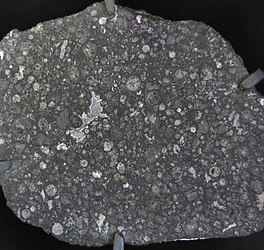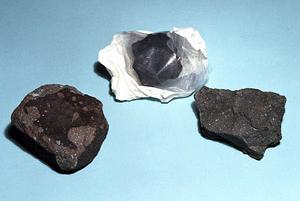碳質球粒隕石
| 碳質球粒隕石 | |
|---|---|
| — Class — | |

| |
| 阿顏德隕石的薄片顯示出圓形的隕石球粒。 | |
| 類型 | 球粒隕石 |
| Alternative names | C球粒隕石 |
碳質球粒隕石或C球粒隕石是球粒隕石,至少有8種已知的群組和許多尚未分類的隕石屬於這一類型,它們包括許多種已知的原始隕石。碳質球粒隕石只佔墜落隕石總數的一小部分(4.6%)[1]。
一些著名的碳質球粒隕石是:阿顏德隕石、默奇森隕石、奧蓋爾隕石、Ivuna、默里隕石、塔吉什湖隕石、和薩特磨坊隕石。
成分和分類
[编辑]
碳質球粒隕石根據獨特的成份,反應它們源自的母體進行分類。這些分類都以著名的隕石-往往都以最先發現的隕石-命名。
幾種值得注意的碳質球粒隕石包括:CM群和CI群,包含高百分比的水(從3%至22%)[2],和有機化合物。它們的主要成分是矽酸鹽、氧化物、硫化物,典型的特色礦物是橄欖石和蛇紋石。揮發性、有機化學品和水的存在,顯示它們形成時沒有經歷過有影響的加熱(>200°C),因此它們的組成被認為與凝聚出太陽系的太陽星雲相近。其它的C球粒隕石,像是CO、CV、和CK球粒隕石,相對的缺乏揮發性化合物,並且其中一些在其母體小行星經歷了重大的加熱。
CI群
[编辑]此群的名稱來自Ivuna,它的化學成份被測量出最接近太陽的光球層,忽略氣體元素和像鋰這種在核反應中被摧毀的元素,因而描述出太陽光球的成分類似於它們在CI球粒隕石中的。在這樣的意義下,它們是已知化學成分最原始的隕石。
CI球粒隕時通常包含很高比例的水(可以高達22%)[2],與氨基酸形式的有機物[3]和多環芳香烴[4]。水蝕變促成水合層狀矽酸鹽、磁鐵礦和橄欖石結晶在黑色的基質內發生,並可能導致隕石球粒的缺乏。它們被認為不曾被加熱至50 °C(122 °F)以上,這表明他們是在太陽星雲較冷的外層凝聚的。
已經觀察到五種墜落的CI球粒隕石:Ivuna、奧蓋爾隕石、Alais、Tonk和Revelstoke,還有一些其它的在日本於南極洲的探勘場所發現。一般情況下,CI球粒隕石的極度脆弱,導致他們在地面上很容易受到風化,因此它們在墜落到地球表面後不會存活太長的時間。
CV群
[编辑]
這一群的名稱來自維加拉諾隕石(Vigarano meteorite),這一類型的球粒隕石大部分屬於沉積岩型3。
觀察到的CV墜落隕石有:
CM群
[编辑]這群隕石的名稱來自Mighei,但是最著名與被研究得最多的卻是默奇森隕石(Murchison meteorite)。已經觀察到許多眾所周知的CM群球粒隕石含有豐富且複雜的有機化合物,像是氨基酸和嘌呤/嘧啶鹼基[5][6]。
CR群
[编辑]這一群的名稱來自Renazzo(義大利費拉拉省),智神星被懷疑是最可能的母體[5]。被觀測到的CR群墜落隕石有:
- Al Rais
- Kaidun
- Renazzo
其它著名的CR球粒隕石還有:
- Dar al Gani 574
- El Djouf 001
- NWA 801
CH群
[编辑]"H"代表"高金屬",因此CH群的球粒隕石可能包含高達40%的金屬[7],這使它們成為所有的球粒隕石集團中金屬量最豐富的。第一顆被發現的此類隕石是ALH 85085。化學上,這類隕石與CR和CB群的密切相關。所有的標本都只屬於石隕石類型的2或3[5]。
CB群
[编辑]
這群的名稱源自最有代表性,來自澳大利亞洲bencubbin的隕石。儘管這些隕石含有50%多種鎳鐵金屬,但因為它們的礦物和化學性質與CR群碳質球粒隕石有強烈的關聯,所以沒有歸類為中隕鐵 [5]。
CK群
[编辑]這個群的名稱源自澳大利亞的Karoonda。這群隕石和CO群與CV群有著密切相關[5]。
CO群
[编辑]這群隕石的名稱來自法國的Ornans。隕石球粒的大小平均只有0.15 毫米。它們都屬於石隕石3。
著名的墜落CO碳質球粒隕石:
- Ornans
- Kainsaz
- Warrenton
- Moss
著名的發現CO碳質球粒隕石:
- Dar al Gani 749
未分群的
[编辑]最著名的成員:
有機物
[编辑]
Ehrenfreund等人(2001年)[3]發現在Ivuna和Orguei的氨基酸含量比CM隕石(~30%)的濃度低很多,並且它們在β-丙氨酸、甘氨酸、γ-Aminobutyric acid和β-Amino-n-butyric-acid的成分明顯偏高,但α-aminoisobutyric acid (AIB)和isovaline偏低。這意味著它們是由不同的通路合成,以及在與CM隕石不同的母體中形成。在CI和CM碳質球粒隕石中,大多數有機化合物碳是一種不溶性的複雜材料;這類似於對油母質的描述。火星隕石ALH84001(一顆無粒隕石)也是類似油母質的物質。
CM隕石的默奇森有超過70外星的胺基酸和包括羧酸、羥基羧酸、磺酸、磷酸、脂肪族、芳香和極性碳氫化合物、雜環化合物、羰基化合物、酒精、胺和醯胺等的其它化合物。
中國著名的碳質球粒隕石
[编辑]- 陝西寧強碳質球粒隕石(於1983年發現)
相關條目
[编辑]參考資料
[编辑]- ^ Bischoff, A.; Geiger, T. Meteorites for the Sahara: Find locations, shock classification, degree of weathering and pairing. Meteoritics. 1995, 30 (1): 113–122. Bibcode:1995Metic..30..113B. ISSN 0026-1114.
- ^ 2.0 2.1 Norton, O. Richard. The Cambridge Encyclopedia of Meteorites. Cambridge: Cambridge University Press. 2002: 121–124. ISBN 0-521-62143-7.
- ^ 3.0 3.1 Ehrenfreund, Pascale; Daniel P. Glavin, Oliver Botta, George Cooper, and Jeffrey L. Bada. Extraterrestrial amino acids in Orgueil and Ivuna: Tracing the parent body of CI type carbonaceous chondrites. Proceedings of the National Academy of Sciences. 2001, 98 (5): 2138–2141. Bibcode:2001PNAS...98.2138E. PMC 30105
 . PMID 11226205. doi:10.1073/pnas.051502898.
. PMID 11226205. doi:10.1073/pnas.051502898.
- ^ Wing, Michael R.; Jeffrey L. Bada. The origin of the polycyclic aromatic hydrocarbons in meteorites. Origins of Life and Evolution of the Biosphere. 1992, 21 (5-6): 375–383. Bibcode:1991OLEB...21..375W. doi:10.1007/BF01808308.
- ^ 5.0 5.1 5.2 5.3 5.4 "Carbonaceous chondrite" Meteorite.fr: All About Meteorites: Classification 互联网档案馆的存檔,存档日期2009-10-12.
- ^ APOD: 2012 April 28 - Sutter's Mill Meteorite. APOD. NASA & MTU. 2012-04-28 [2012-05-06]. (原始内容存档于2012-04-29).
- ^ Norton, O. Richard. The Cambridge Encyclopedia of Meteorites. Cambridge: Cambridge University Press. 2002: 139. ISBN 0-521-62143-7.
- Carbonaceous chondrites at The Encyclopedia of Astrobiology, Astronomy, and Spaceflight (页面存档备份,存于互联网档案馆)
- Gilmour, I.; Wright, I.; Wright, J. Origins of earth and life. Bletchley: The Open University. 1997. ISBN 0-7492-8182-0.
外部連結
[编辑]- Carbonaceous Chondrite Images (页面存档备份,存于互联网档案馆) from Meteorites Australia - Meteorites.com.au
- http://internt.nhm.ac.uk/cgi-bin/earth/metcat/list.dsml?Grp=CI&sort=Name&recLimit=100&countscripts=/generic/scripts/countscripts.js&gpVal=CI&sqlpageinfo=5:1:0&=%3E[失效連結]
| |||||||||||||||||||||||||||||||||||||||||||||||||||||||||||||||||||||||||
Text is available under the CC BY-SA 4.0 license; additional terms may apply.
Images, videos and audio are available under their respective licenses.
